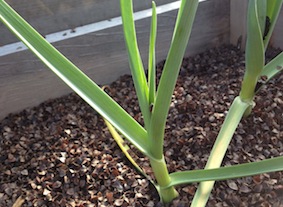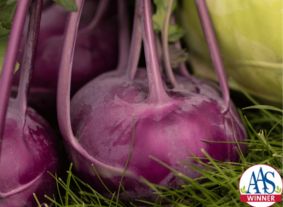Giving Garlic a Go
Views: 3401

In mid March I reported that my garlic had already sprouted and was about 3 inches tall already. With the early warm weather, it shouldn’t have been much of a surprise.
But it was a surprise, and mainly because I had totally forgotten I had planted garlic in the first place.
Last September, a fellow community garden member unexpectedly passed away. In October the garden held a memorial service for him. It was a beautiful gathering, the kind that brings near-strangers together to talk about shared interactions with a common friend, now gone. We milled about before and after the service, chatting, checking our plots. A fellow gardener I hadn’t spoken with much before came up to me and the gardeners nearby. She offered garlic to plant on this day of remembrance.
When I spotted the green shoots in mid March, this all came back—David, the service, the hawk that soared above the crowd that day, the generosity. As an on-the-spot impulse planting, I needed to read up on my new crop. If for no other reason than to harvest at least something, make a meal of it, and raise a glass to a departed friend.
Hard-neck garlic
The garlic variety name, I have no idea. I have since spoken to the person who gifted the garlic, and she doesn’t recall, either. What she does remember is this: This is hard-neck garlic, which is appropriate for northern climates, as opposed to soft-neck garlic prevalent in warmer-winter regions. The stuff you buy in the supermarket is more than likely soft-neck garlic.
Growing
Plant garlic in the fall. Make several 2- to 3-inch-deep holes in your soil, about 4 inches apart, and plop a single clove (pointy end up) in each hole. Cover with soil. As you clean up your garden for the winter, lay an insulating blanket of mulch—dry leaves, straw, etc.—over the area.
The general rule is to feed the bulbs by sprinkling compost or a general fertilizer (I used a 1.5-0.7-1.5 organic formulation) come spring. And give them a good dose of water. My food and water didn’t make it to my garlic until late April, and with the lack of rainfall in New England this year, the now-8-inch-tall garlic greens are a tad yellow at the tips.
I’ll continue feeding and watering throughout the summer. By midsummer, a flowering stalk will rise up from each plant. It’s a good thing apparently, because the flowers that develop on top—called scapes—are a delicacy that can be sprinkled over salads and such. But I’ll cut them off early on, while the buds are still developing, so that this flower stalk doesn’t steal too much energy from the still-growing garlic bulbs beneath the soil.
I have a very good feeling about this garlic.
Meet Ellen Wells
When you’re raised on a farm, you can’t help but know a thing or two about gardening. Ellen Wells is our expert on edible gardening.…







